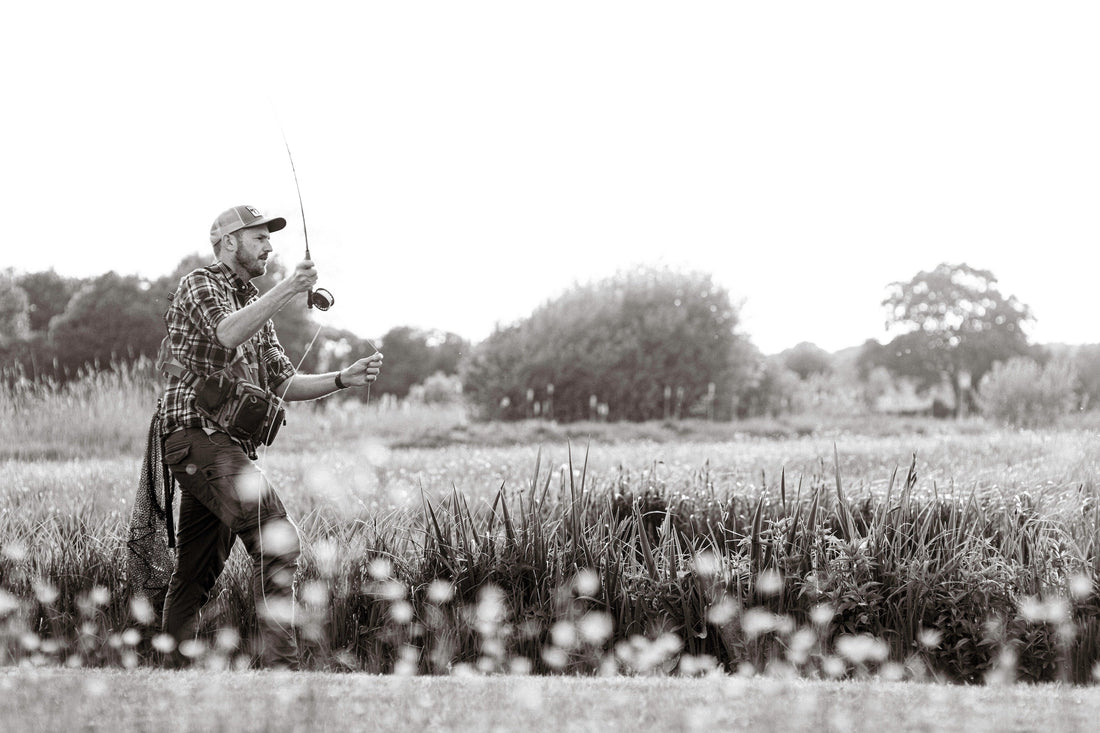Picture this…
You stealthily sneak down to the creek trying to make your way into the water and see an explosion of tiny insects swarming around the water. Then you see something that tells you it’s going to be a great day of fly fishing…
Slurp… Slurp… Splash!
Those trout are smashing bugs on the surface and now it’s time to throw some dry flies!
If you haven’t had a chance to toss dry flies to massive rising trout, then you haven’t lived, my friend! This is one of the joys of fly fishing that will never get old. So, let’s get to it!
What is the Difference Between Wet and Dry Flies?

Dry Fly Fishing Basics - What the Heck is Dry-Fly Fishing?

Dry fly fishing is a method of fly fishing in which anglers use a type of artificial fly that floats on the surface of the water, to mimic the appearance of an aquatic insect. The goal of dry fly fishing is to trick a fish into taking the fly by imitating the appearance and behavior of a natural insect.
The use of artificial flies in fishing dates back to ancient civilizations in Europe and Asia, where anglers used materials like feathers, fur, and plant fibers to create lures that resembled insects and other small aquatic creatures. Today, dry fly fishing is known as the “holy grail” of fly fishing for many. It can be used for a variety of species of fish, including trout, bass, panfish, and others.
Whether you're a seasoned pro or a beginner, there's something incredibly thrilling about seeing a fish rise to the surface and slurp up a carefully presented dry fly.
Gear for Dry Fly Fishing for Trout - How to Pick the Right Dry Fly
Picking the right dry fly for fly fishing can be a challenge, especially for beginners. With so many different patterns and styles to choose from, it can be difficult to know which flies to slap on your fly rod in any given situation. I’m going to talk about the key factors to consider when selecting a dry fly, and offer some tips and strategies for choosing the right fly for your next day on the river.
The first thing to consider when picking a dry fly is the type of fish you're targeting. Different species of fish prefer different types of insects and other aquatic life, so it's important to choose a fly that will appeal to the fish you're trying to catch. For example, if you're targeting trout with dry flies, you might want to choose a dry fly that imitates a mayfly or a caddis fly, as these insects are common food sources for trout. On the other hand, if you're fishing for bass, you might want to choose a fly that imitates a grasshopper or a dragonfly, as these insects are also popular food sources for bass.
Another important factor for dry fly anglers to consider is the time of year and the weather conditions. Different types of insects are active at different times of the year, so it's important to choose a fly that matches the season and the weather. For example, if you're fishing in the spring, you might want to choose a fly that imitates a mayfly or a caddis fly, as these insects are often active in the early part of the year. On the other hand, if you're fishing in the summer, you might want to choose a fly that imitates a grasshopper or a dragonfly, as these insects are more active during the warmer months.
In addition to the type of fish you're targeting and the time of year, there are a few other factors to consider when picking a dry fly for rising fish. These include the water conditions (e.g., the clarity and flow of the water), the size of the fly, and the color of the fly. When choosing a fly, it's important to think about these factors and choose a fly that will be most effective in the given conditions.
Picking the right dry fly for fly fishing requires careful consideration of the type of fish you're targeting, the time of year and weather conditions, and other factors like water clarity and flow, size, and color. By taking the time to carefully select the right fly and “match the hatch”, you'll catch more fish and have a lot more fun on the water.
How to Cast a Dry Fly Pattern to a Trout

Learning how to cast a dry fly is an important skill for any fly fisherman or fisherwoman. While it may seem intimidating at first, with practice and the right techniques, anyone can learn how to cast a dry fly effectively.
Before we get started, it's important to note that dry fly casting is a different technique than other types of fly casting, such as nymphing or streamer fishing. Dry fly casting is all about precision and delicacy, as the goal is to present the fly gently and naturally on the water's surface. With that in mind, here are a few key points to keep in mind as you learn how to cast a dry fly:
Choose the right rod and line: The type of rod and line you use will have a big impact on your casting ability. For dry fly fishing, many folks use a rod with a medium-fast to fast action and a line with a weight-forward taper. This will give you the power and precision you need to make delicate, accurate casts.
On the other hand, it can be incredibly fun to use a buttery glass rod with a slow action with a weight-forward taper. A glass rod will give you a slower swing and will make even smaller fish a blast to fight.
Use a reach cast: A reach cast is a type of cast that involves reaching out to the side of your body as you make the cast. This allows you to lay out the fly line in a straight, controlled manner, which is important for making delicate presentations with a dry fly. To make a reach cast, start by pointing the rod tip at the target and making a backcast. As the line unrolls behind you, reach out to the side with your non-casting hand to help control the line. Then, make a forward cast, using the same motion as the backcast but in the opposite direction.
Use a soft touch: When casting a dry fly, it's important to use a soft touch to avoid disturbing the water too much. This means making smooth, controlled movements with the rod, and avoiding abrupt stops or jerky motions.
Practice your timing: Timing is critical when it comes to dry fly casting. You'll want to cast your fly just ahead of the fish, and allow it to drift naturally in the current. This requires good timing and coordination, and is something that comes with practice.
How to Drift and Mend Your Line in a Trout Stream
Best Dry Flies for Dry Fly Fishing for Trout
When it comes to fly fishing, having a selection of effective dry flies in your fly box is essential. Being able to “match the hatch” and knowing what fish are feeding on is one of the easiest “hacks” to catching more fish. Here are some of the most popular dry flies out there:
Blue Wing Olive: A blue wing olive fly is designed to imitate the appearance of a, you guessed it… blue wing olive. The fly is typically made from a variety of materials, including feathers, fur, and thread, and is designed to be lightweight and realistic in appearance. It is particularly effective during the late spring and early summer months, when blue wing olives are commonly found on the water.
Elk Hair Caddis: The elk hair caddis is another versatile dry fly that imitates a variety of aquatic insects, including caddisflies and stoneflies. It's known for its lifelike appearance and effectiveness at attracting fish, making it a popular choice for fly anglers.
Royal Wulff: The Royal Wulff is a dry fly that imitates mayflies and other aquatic insects, and is a popular choice for fishing in streams and rivers. It's known for its bright, eye-catching appearance and effectiveness at attracting fish, and is a great fly to have in your box.
Parachute Adams: The parachute Adams is a variation on the classic Adams dry fly, with a distinctive parachute-style hackle that helps the fly float more naturally on the water's surface. It's a great fly for fishing in a variety of conditions, and is a must-have for any fly box.
All of these classic flies can be found inside the Guide’s Stash Fly Kit HERE.
If you’re looking for the ideal fly box that’s packed with all the dry flies, nymphs, and streamers you need to catch loads of fish, we’ve got you covered.

So, to tie this all up… If you’re interested in going dry fly fishing, just do it!
Some of my best memories have been chasing native cutthroat trout up a tiny mountain stream with a Royal Wulff or plucking bluegill after bluegill out of my local creek with a little Parachute Adams. So, get out there and fish!

